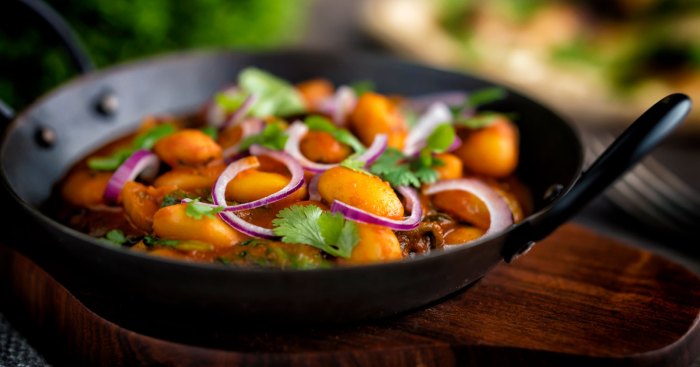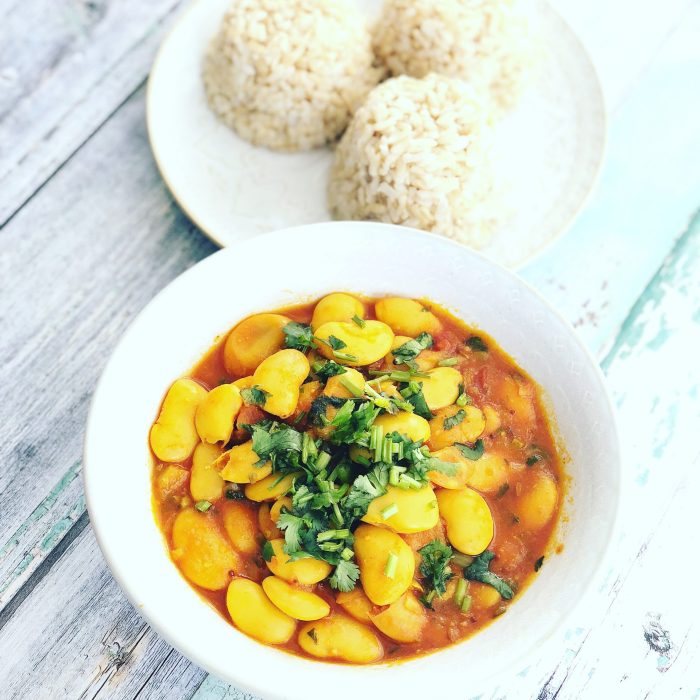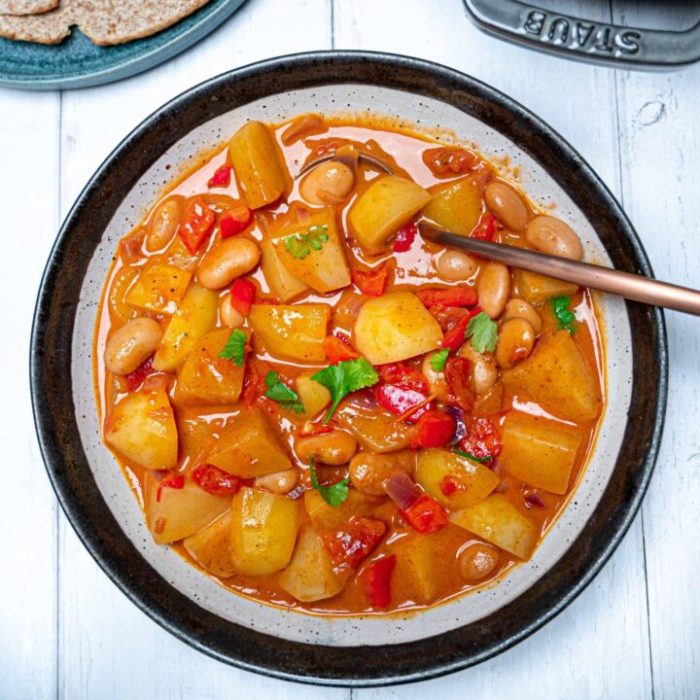Prepare to tantalize your taste buds with the delectable world of butter beans curry, a culinary masterpiece that seamlessly blends nutritional goodness with tantalizing flavors. From its humble origins to its widespread popularity, this dish has captivated hearts and palates around the globe.
Delving into the heart of butter beans, we uncover a treasure trove of essential nutrients that nourish our bodies. Rich in protein, fiber, and an array of vitamins, these beans play a vital role in maintaining a healthy lifestyle.
Nutritional Value and Health Benefits

Butter beans, also known as lima beans, are a nutrient-rich legume packed with essential vitamins, minerals, and fiber. Their nutritional profile makes them a valuable addition to a balanced diet, offering a range of health benefits.
After a hearty serving of butter beans curry, why not indulge in a delectable treat? Try our irresistible baked oats recipe for a sweet and satisfying dessert. Its creamy texture and wholesome ingredients will tantalize your taste buds. Don’t miss out on this culinary delight that complements your butter beans curry perfectly.
Protein and Fiber
Butter beans are an excellent source of protein, providing approximately 15 grams per cup. This plant-based protein is easily digestible and contributes to muscle growth, repair, and overall energy levels. Additionally, butter beans are high in fiber, with around 12 grams per cup.
Fiber promotes satiety, aids digestion, and supports a healthy gut microbiome.
Vitamins and Minerals
Butter beans are a good source of vitamins and minerals, including iron, potassium, magnesium, and folate. Iron is crucial for red blood cell production, while potassium supports heart health and blood pressure regulation. Magnesium contributes to nerve and muscle function, and folate is essential for DNA synthesis and cell growth.
Health Benefits
- Improved Heart Health:The fiber and potassium in butter beans contribute to lower cholesterol levels and improved blood pressure, reducing the risk of heart disease.
- Blood Sugar Control:The fiber in butter beans slows down the absorption of sugar into the bloodstream, helping to regulate blood sugar levels and prevent spikes.
- Improved Digestion:The fiber in butter beans promotes regular bowel movements and supports a healthy digestive system.
Culinary Applications
Butter beans, with their creamy texture and mild flavor, offer versatility in culinary preparations. They serve as a staple ingredient in various cuisines, from traditional Indian dishes to hearty Southern American fare.
Butter beans can be prepared in a multitude of ways, including boiling, baking, and sautéing. Boiling remains the most common method, resulting in tender beans that absorb flavors well. Baking, on the other hand, yields a slightly firmer texture, making them suitable for salads or as a side dish.
Sautéing imparts a caramelized exterior while preserving the soft interior, ideal for quick and flavorful dishes.
Incorporation into Cuisines
Butter beans seamlessly integrate into a wide range of cuisines, adding both nutritional value and culinary depth.
- Indian Cuisine:Butter beans are a beloved ingredient in many Indian curries, such as the creamy and flavorful rajma masala. They also feature prominently in sambar, a traditional South Indian lentil stew.
- Mediterranean Cuisine:In Mediterranean dishes, butter beans are often combined with vegetables and herbs to create hearty stews and salads. They add a creamy texture to hummus and falafel, enhancing their flavor and richness.
- Southern American Cuisine:Butter beans are a staple in Southern American cooking, particularly in dishes like Hoppin’ John, a traditional New Year’s Day meal featuring black-eyed peas and rice. They also add a creamy and savory element to soups, stews, and casseroles.
Butter Beans Curry

Butter beans curry is a delicious and flavorful dish that is enjoyed by people of all ages. It is a popular dish in many parts of the world, and there are many different variations of the recipe. The origins of butter beans curry are not entirely clear, but it is thought to have originated in India.
Traditional butter beans curry is made with a variety of spices, including turmeric, cumin, coriander, and garam masala. These spices give the curry a warm and earthy flavor. The curry is also made with coconut milk, which gives it a rich and creamy texture.
The main ingredient in butter beans curry is, of course, butter beans. Butter beans are a type of legume that is high in protein and fiber. They are also a good source of vitamins and minerals.
Butter beans curry can be served with a variety of side dishes, such as rice, roti, or naan. It can also be served with a side of yogurt or raita. Butter beans curry is a delicious and nutritious dish that is perfect for any occasion.
Key Ingredients and Flavors
The key ingredients in butter beans curry are butter beans, spices, and coconut milk. The spices used in the curry vary depending on the region, but common spices include turmeric, cumin, coriander, and garam masala. These spices give the curry a warm and earthy flavor.
Coconut milk gives the curry a rich and creamy texture.
Step-by-Step Instructions
To make butter beans curry, you will need the following ingredients:
- 1 can (15 ounces) of butter beans, drained and rinsed
- 1 tablespoon of olive oil
- 1 onion, chopped
- 2 cloves of garlic, minced
- 1 tablespoon of ginger-garlic paste
- 1 teaspoon of turmeric powder
- 1 teaspoon of cumin powder
- 1 teaspoon of coriander powder
- 1 teaspoon of garam masala
- 1 can (13 ounces) of coconut milk
- Salt to taste
Instructions:
- Heat the olive oil in a large saucepan over medium heat. Add the onion and cook until softened, about 5 minutes.
- Add the garlic and ginger-garlic paste and cook for 1 minute more.
- Stir in the turmeric powder, cumin powder, coriander powder, and garam masala. Cook for 1 minute, or until the spices are fragrant.
- Add the coconut milk and butter beans. Bring to a simmer and cook for 15 minutes, or until the butter beans are heated through.
- Season with salt to taste.
- Serve hot with rice, roti, or naan.
Variations and Adaptations: Butter Beans Curry
Butter beans curry is a versatile dish that can be easily adapted to suit various tastes and dietary preferences. Let’s explore some creative ways to customize this delicious dish.
Vegetable Variations
- Add a variety of vegetables to your curry, such as carrots, celery, bell peppers, onions, or spinach, for added flavor and nutritional value.
- Roast or grill vegetables before adding them to the curry for a smoky and caramelized taste.
Spice Adaptations
- Experiment with different spices to create unique flavor profiles. Consider adding garam masala, turmeric, cumin, coriander, or red chili powder.
- Use fresh herbs like cilantro, basil, or mint to add a burst of freshness and aroma.
Meat and Protein Options, Butter beans curry
- Add chicken, beef, or lamb to your curry for a hearty and protein-rich meal.
- Use tofu, tempeh, or lentils as a vegan protein source.
Dietary Adaptations
- For a gluten-free option, use gluten-free bread or rice as a side dish.
- To make a vegan curry, omit dairy products and use plant-based milk or yogurt instead.
Presentation and Serving Suggestions
The vibrant hues and textures of butter beans curry make it a visually appealing dish. To enhance its presentation further, consider incorporating colorful garnishes and accompaniments that complement its flavors.
When serving butter beans curry, it pairs well with various sides that offer a range of textures and tastes. Rice, with its soft and fluffy texture, provides a neutral canvas for the curry’s bold flavors. Roti, a flatbread with a slightly chewy texture, adds a rustic touch to the meal.
Naan bread, with its soft and pliable texture, can be used to scoop up the curry and its accompaniments.
Garnishes
- Fresh cilantro leaves: Adds a vibrant green color and a refreshing herbaceous flavor.
- Chopped red onions: Provides a sharp and slightly sweet contrast to the curry.
- Sliced green chilies: Offers a spicy kick and a vibrant green hue.
- Roasted cashew nuts: Adds a crunchy texture and a nutty flavor.
Accompaniments
- Plain yogurt: Provides a cooling and tangy contrast to the spicy curry.
- Lemon wedges: Offers a bright and acidic note that complements the richness of the curry.
- Mango chutney: Adds a sweet and tangy dimension to the dish.
- Papadum: A crispy and flavorful flatbread that can be used to scoop up the curry.
Cultural Significance

Butter beans curry holds a special place in various cultures worldwide, carrying deep-rooted traditions and culinary significance.
In many regions, butter beans curry is an integral part of festive occasions and celebrations. For instance, in South India, it is a staple dish during Onam, a harvest festival celebrated by the Malayali community. The curry represents prosperity and abundance, and its rich, creamy texture symbolizes the bounty of the season.
Culinary Customs and Traditions
- In parts of Africa, butter beans curry is associated with communal gatherings and hospitality. It is often prepared in large pots and shared among family and friends, fostering a sense of togetherness.
- In the Caribbean, butter beans curry is a beloved comfort food, particularly in Jamaica. It is often paired with rice and peas, forming a staple dish that evokes feelings of home and nostalgia.
- In the Southern United States, butter beans curry has deep historical roots. It is a traditional dish in soul food cuisine, originating from African culinary influences. The curry is often prepared with smoked meats and vegetables, reflecting the region’s rich agricultural heritage.
Last Recap

As we bid farewell to our culinary exploration, let us savor the lingering flavors of butter beans curry, a dish that has delighted taste buds and nurtured bodies for generations. Whether enjoyed as a comforting meal or a celebratory feast, this culinary creation stands as a testament to the transformative power of food.








